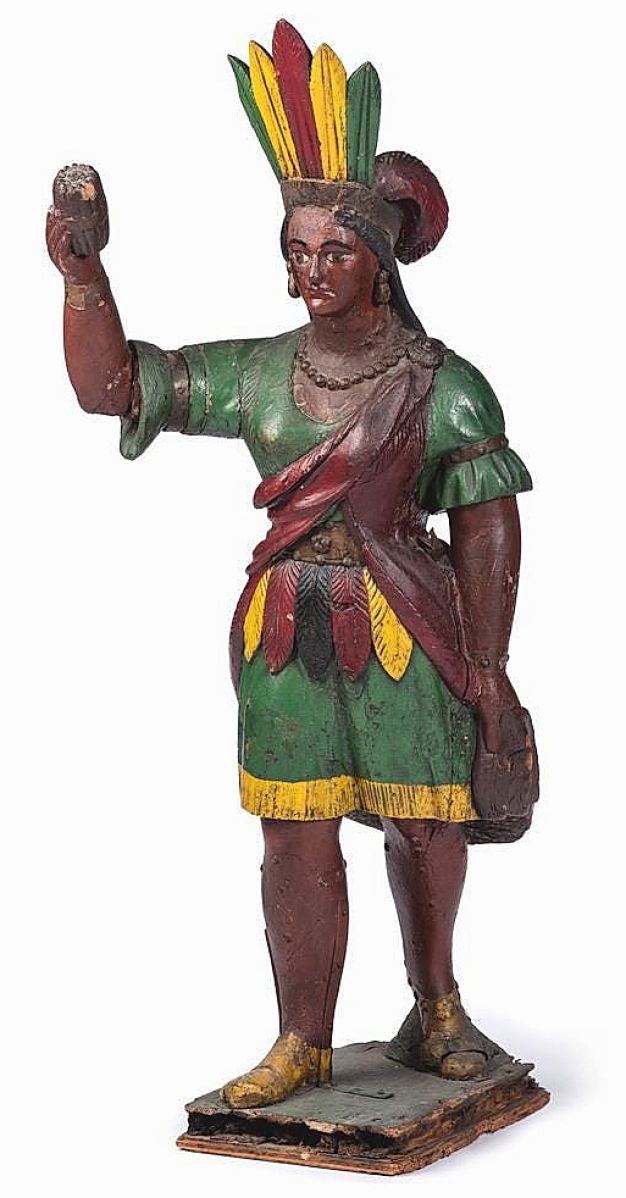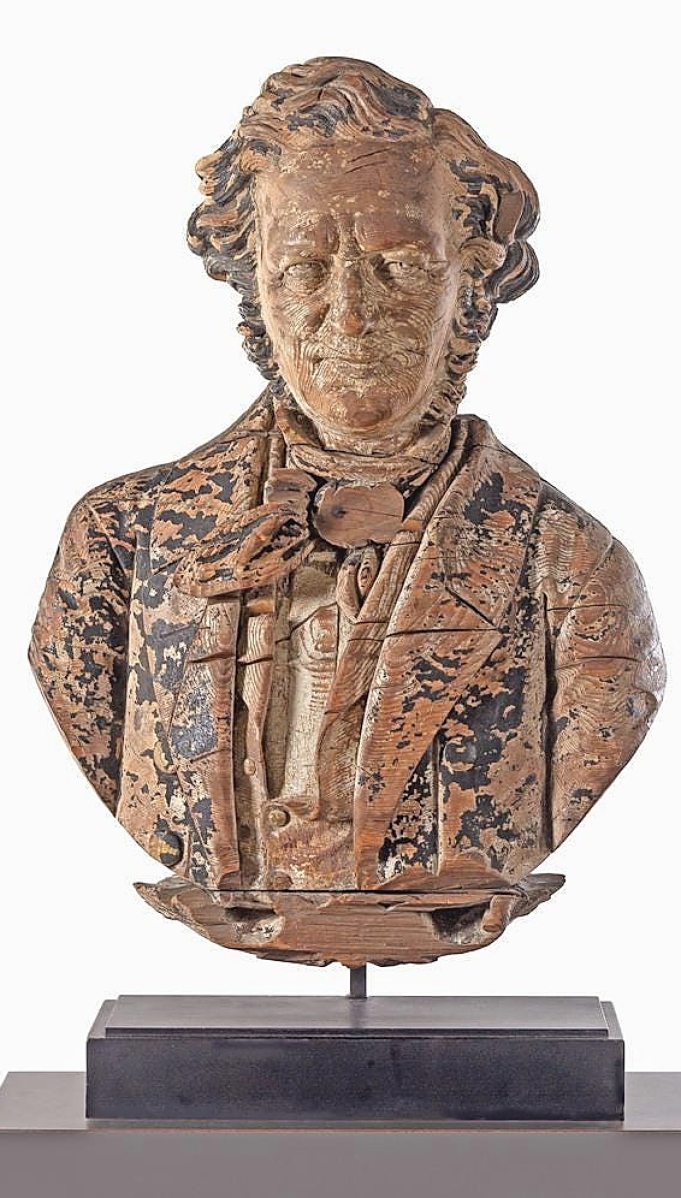
The sale’s top lot at $35,200 was “George Washington at Princeton, 1777” by American artist Alonzo Chappel (1828-1887). Chappel completed the work 80 years after Washington took his stand at Princeton, a battle that would build morale among the Revolutionaries. The oil on canvas, 24 by 18 inches, came from the collection of Noel and Kathryn Dickinson Wadsworth.
Review by Greg Smith, Catalog Photos Courtesy Cowan’s Auctions
CINCINNATI – Four collections and numerous other consignors combined for more than 800 lots in Cowan’s American Furniture, Folk & Decorative Arts sale March 9-10. The auction would gross more than $790,000 total.
Works from the collection of Atlanta collectors Noel and Kathy Wadsworth found favor. The Wadsworths were founders of the Auburn Fine Arts Museum and have a gallery there named in their honor. Among their old possessions was the sale’s top lot, “George Washington at Princeton, 1777,” an 1857 oil on canvas by Alonzo Chappel (1828-1887). The work featured Washington on the back of a white horse in a calamitous scene – soldiers behind him charging, those in front of him falling backward – as he leads his troops forward to the line. At the very moment depicted in the painting, period accounts tell of Washington’s words: “Parade with us my brave fellows! There is but a handful of the enemy and we shall have them directly!” They did have them and the battle at Princeton was a major morale boost for the Revolutionaries. The painting, which had been exhibited at The Jule Collins Smith Museum of Fine Art at Auburn University in 2004, went on to sell for $35,200.
“Almost everything that we offered from the Wadsworth collection in this sale had a depiction of George Washington,” Cowan’s director of Americana, Ben Fisher, said. “Chappel’s ‘Washington at Princeton’ had never been on the auction market before, it really captured people’s attention. It’s such a strong depiction.”

Selling for $21,760 was this leaner figure from a tobacco store, 76 inches high. The firm left it unattributed, but said it had previously been attributed to Thomas Brooks. It purportedly hung in a Pittsburgh tavern from 1925 to 1988. Collection of James Sanders.
Also from the Wadsworth collection was a bronze bust of Washington after Jean-Antoine Houdon (French, 1741-1828), which went on to bring $9,600.
Fisher says more works from the Wadsworth collection will appear in May and June sales.
Cigar store Indians were another hot category. A leaner figure from New York, circa the 1860s, went out at $21,760. To the underside of the skirt was painted RO Camp and the figure, 76 inches high, reportedly hung in a Pittsburgh tavern from 1925 to 1988. The figure was from the collection of James A. Sanders, an Indiana collector who spent his life as an educator. In 1985, he became the University of Southern Indiana’s first director of Historic New Harmony. His dedication to material culture led him to pursue associations with the Decorative Arts Trust, Evansville Preservation Alliance and the Evansville Museum of Arts. From another collection came a Native American maiden in the manner of Samuel Anderson Robb, probably New York, circa 1900, that went out at $20,000. It measured 58 inches high.
The results were strong, Fisher said, given the restorations on each.
Carved figures, carnival games, trade signs and folk art came forth from Wisconsin collector, Paul Bentley. Paul and his wife, Judith, installed their collection on the western shore of Lake Michigan in a home nicknamed “The Crayola House,” designed by Margaret McCurry. It takes an eye for flair to live in a postmodern home, and the Bentleys’ collection was exhibit A.

At 58 inches high, this carved and polychromed painted pine Native American maiden cigar store figure would sell for quadruple estimate at $20,000. The firm said it was made in the manner of New York carver Samuel Robb, circa 1900. It came out of a Maryland interior designed by Robert Metzger.
“It was really Paul that was doing most of the collecting. He had a diverse interest when it came to folk art,” Fisher said. “He bought whimsical things. He was very interested in diving, so there’s a strong nautical theme in the collection. It’s great to see a folk art collection displayed in such a contemporary home and displayed as if it was contemporary art. A lot of these things tend to be fairly unique or at least fairly limited in quantities and tend to stand out. There are a few things from the Bentley collection that I don’t think I’ll ever see again, or at least not for a long time.”
The couple only recently purchased a pine sternboard portrait bust of Daniel Webster, circa 1880s, from the October 2019 sale of the Stephen and Petra Levin collection at Sotheby’s. They paid $11,875 then and it appreciated a bit, selling for $15,000 at Cowan’s. “Sometimes you take things away from New York and you get a different pool of buyers,” Fisher said. The figure’s first provenance line traced it back to the Barbara Johnson Whaling Collection and it had been included in “The Hunt For the Whale,” a 1967 exhibition at the Museum of American Folk Art.
At $8,151 was a cut and colored glass mounted lighted apothecary sign. Though it did not have an attribution, Fisher said that it looked nearly identical to examples made by the Travis, McLewee & Ferry company in New York, which specialized in artistic glass fixtures. The sign had been converted to electric light but it would have run on a flame at the time it was made. The closest comparable result that Fisher found was about 20 years old. More color was added with an Indian Motorcycles-style neon sign, featuring a rainbow of neon colors, that brought $7,500. Rising to $6,250 was a carved and painted Popeye torpedo riding toy, 38 inches high and from the 1930s. Circa 1920 and said to be from a Camden, Maine, seafood restaurant was a toothy whale-form sign in white paint with yellow eyes, 64 inches long, that brought $5,938. It had provenance to Pennsylvania dealer Roger Winter. On the carnival side of things was a William F. Mangels painted cast iron clown-form automaton target with bright paint. At 24½ inches high, the clown with target extending upward from his hat, went out at $5,625.

Highest among the furniture lots was a Federal chest of drawers inlaid with fans and central fylfot. In cherrywood, the auction house believed it to be circa 1840 and possibly from Greene County, Tenn. It sold for $15,360, nearly double estimate.
Formal furniture was ruled by inlaid works. Nearly doubling estimate for $15,360 was a Federal chest of drawers inlaid with fans and central fylfot. The example in cherrywood was believed to have been from Greene County, Tenn., and dating to 1840. From the Eighteenth Century was a Virginia or mid-Atlantic Chippendale inlaid walnut and yellow pine highboy. The top central drawer featured the large initials “TA” and it sold for $8,750. At the same price was a Federal mahogany and walnut veneered serving table believed to be from Maryland, circa 1790.
“We see a strong interest in Southern furniture, given our proximity to the region,” Fisher said. “Cincinnati isn’t that far from Maryland and those states, so we do get strong interest from those areas.”
Without the inlay was a Chippendale-style shell-and-block carved mahogany chest on chest by Twentieth Century master cabinetmaker John Gaar Jr (1913-2001). It was executed in the style of those by Goddard and Townsend and brought $9,600. Gaar Jr was the son of Austrian emigree John Gaar Sr, who set up a furniture restoration shop in Milwaukee, Wisc., after arriving to the United States in 1929. Both Gaar Jr and his brother, Joe, followed their father into the business.
“The period object is worth ten if not 100-times more depending on its history, but it has this look and it’s made in the similar quality,” Fisher said. “It shows people are interested in craftsmanship and the aesthetic regardless of the actual age.”

Paul and Judy Bentley bought this pine portrait bust of Daniel Webster at the 2019 Sotheby’s sale from the collection of Stephen and Petra Levin. It sold slightly higher this time at $15,000. Ben Fisher said, “Sometimes you take things away from New York and you get a different pool of buyers.”
The Arizona State Museum deaccessioned a number of trade signs in the sale with bidders screaming to $8,750 for a 31-inch-high painted wood Ice Cream sign featuring frosted letters and a bowl with a scoop in it. The work, circa 1850-60, was attributed to Arthur B. Rich. “It was thought to be from the mid-Nineteenth Century,” Fisher said. “If you think about the distribution of ice cream, that is pretty early on in terms of its sale. There are not a ton of ice cream signs from that period that have survived in the condition like this one.”
At $4,160 was an 18-1/8-by-22-1/16-inch painted wood sign advertising Oliver Lippy Tailors. The auction house said that according to architectural surveys, Oliver Lippy (1836-1924) worked as a tailor in Manchester, Md. Among the more remarkable examples was a lenticular tin sign advertising the W. James Sunlight Soap company. From straight on, the sign read “W. James,” viewed from the left it read “Sunlight Soap” and viewed from the right, “Lifebuoy Soap.” The British firm Lever Brothers introduced Sunlight Soap in 1883. The sign brought $3,840.
Fisher described James Sanders as a pure collector. “He was a lifelong collector, buying things at auction and also local estates. I believe some was passed down within his family as well. James Sanders was a historic preservationist, very much involved in Evansville and New Harmony and preserving the history of those areas.”
Apart from the Native American figure, Sanders’ estate supplied more than 161 other lots on the sale’s first day, including an $8,750 result for a molded sheet copper leaping stag weathervane in the manner of E.G. Washburne & Co. A Twentieth Century molded copper shooting Indian weathervane, 47¾ inches high, would bring $5,120. His fine art included a Nineteenth Century English school oil on canvas painting depicting a prize Hereford Bull, with an inscription that said it was bred and fed by a Mr. B. Rogers. It brought $5,000. A golden-tone scene by American artist Brian Coole (b 1939), titled “A View of Quebec, 1759,” went out at $3,750.
All prices quoted include buyer’s premium as stated by the auction house. For more information, www.cowansauctions.com or 513-871-1670.






























